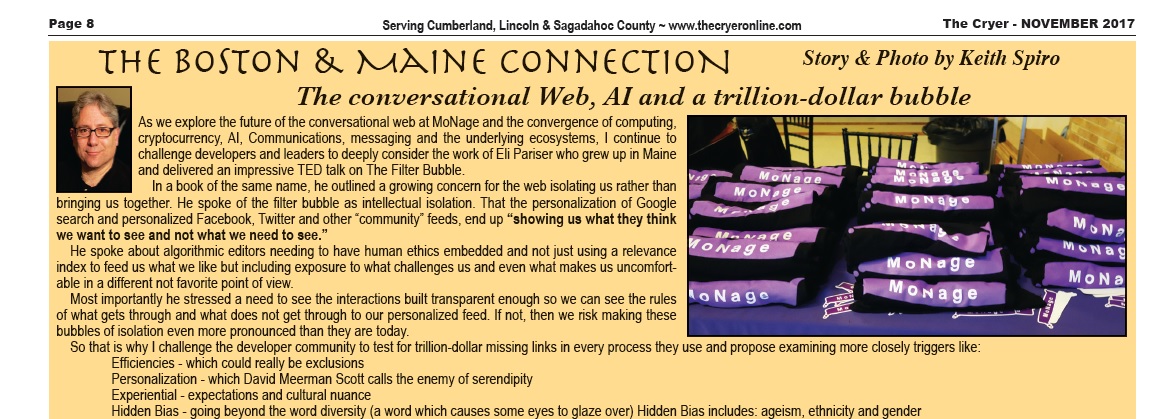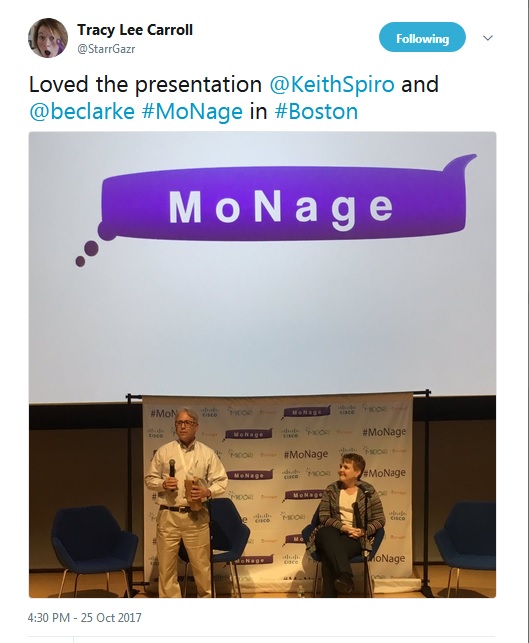The conversational Web, AI and a trillion-dollar bubble.
At MoNage, we explored the future of the conversational web and the convergence of computing, cryptocurrency, AI, Communications, messaging and their underlying ecosystems. I spoke about trillion dollar opportunities and my concerns that tomorrow’s conversational web may well be compromised by today’s failure to fully encompass diverse tech teams.
Joining me on stage was Barbara Clarke, an economist and co-founder of The Impact Seat. Together we read Letters to MoNage – a real time compilation of comments coming out of the multi day presentations and together we represented a clear visual cue of diversity in front of a mostly male audience.
The Challenge of isolated business bubbles
I challenged developers, corporate leaders and brand advisors to deeply consider the work of Eli Pariser who grew up in Maine and delivered an impressive TED talk called The Filter Bubble.
In a book of the same name, he outlined a growing concern for the web isolating us rather than bringing us together. He spoke of the filter bubble as intellectual isolation. That the personalization of Google search and personalized Facebook, Twitter and other “community” feeds, end up “showing us what they think we want to see and not what we need to see.”
He spoke about algorithmic editors needing to have human ethics embedded and not just using a relevance index to feed us what we like but also to include exposure to what challenges us or what will even make us uncomfortable. There is a need to seek differences and not just settle for reinforcement of your favorite point of view. Most importantly he stressed a need to see future online interactions built transparent enough so we can see the rules of what gets through and what does not get through to our personalized feed. If not, then we risk making these bubbles of isolation even more pronounced than they are today.
Trillion Dollar missing links
So that is why I challenge the developer community to test for what I call trillion-dollar missing links. Because, in every process they create, they need to examine, more closely, potential points of failure in:
- Efficiencies –which might really stand for creating exclusions
- Personalization – which David Meerman Scott calls the “Enemy of Serendipity”
- Experiential – if a wide human range of expectations and cultural nuances are ignored
- Hidden Bias – goes well beyond the word – diversity – (a word which causes some eyes to glaze over) Hidden Bias is easily found in areas of age, ethnic and gender exclusion or absence (from the building process).
 Here are just two simple and visible examples of concern:
Here are just two simple and visible examples of concern:
- Latinx. Nielsen- a company that prides itself on reaching inside consumers and homes -points to the projected Latinx buying power of nearly $1.5 Trillion. Annually. With 86% of that community saying the woman is the primary shopper, here are clear gender and ethnic differences to consider. Do you understand their cultural norms? They are not on Linked In. They have begun to create their own social media/social business platforms. Do you understand why? I hope teams look into it. This disconnected bubble is worth $1.5 Trillion a year.
- Baby Boomers. Let me speak as a member of a different Trillion Dollar bubble. Baby Boomers. Each year, for the next thirty years, we are looking at the potential transfer of wealth of nearly $1 Trillion dollars. One Trillion Dollars a year. Look closely at our experiential web & AI interactions. There’s a backlash happening. Note the mentions of Facebook Timeouts and a more shrill shouting rather than dialog taking place nearly everywhere. We are all quite capable of breaking relationships with our banks and the airlines we use. The old fashioned hooks that held us to a business relationship are gone. I want to have an enjoyable user experience. I will find it – if not with your business – than somewhere else.
Trust
How many of us have had enough of struggling to insure accuracy of what we write in text messages on our smaller handheld devices? There’s something about autocomplete that leaves me wanting. Predictive completion is not my friend. Chatbots that don’t understand my nuances annoy me enough to find another vendor. I find this transactional drag on communications totally unacceptable. And so, the word trust begins to grow as a decision point for my spend. If I don’t trust you or your system, I will not be your customer. Ever. My future personal chatbot will duly note that and may block you no differently than today’s email spam. Advertisers take note.
Delivering better results
So, here’s a very simplified approach to fixing problems that exist and to pre-emptively prevent future gaffs. Just look around you. Look at your project team, look at the consultants that you hired and the people running surveys for you. If you look around and everyone looks like you and the individuals delivering the message and answers you’ve asked for looks just like you, You. Have. A. Problem. You don’t need any more bubble based positive reinforcement, you need to be concerned about the people who are not in the room with you.
Don’t let an unpleasant user experience result in the customer or human intermediary shutting down on one another.
Diverse teams deliver better results.
Diverse leadership insures more points of view are heard and acted upon.
Diversity should be obvious.
Your project/business/appeal either is or is not.
There is no maybe.


After this post first appeared, Ben Romano at Xconomy published a great article about the proliferation of voice controlled devices like Alexa and Siri – He raised the question of why they have female personae and warned of potential issues in talking with or developing relationships with machines.
I love his question: Do you treat Alexa/Siri/Cortana/Google Home like a person, a computer, or a corporation? Do you allow or require your kids to treat it like a person? He then morphs it into an additional comment that the tech industry needs more women.
A very interesting take. His story appeared in a January 2018 Xconomy post entitled “hey-alexa-whats-in-a-name-actually-lets-call-you-amazon” There are still plenty of comments on the web about tech companies co-opting human names to blur those lines
Several months later, Keith, but this was very interesting. It’s a good thing that some people are talking about this, as the people I know who have Alexa and Echo don’t seem to differentiate between “it” and a person.